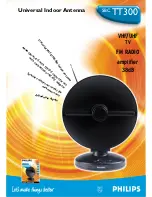
CHA P-LOOP 2.0
Page 9
Perform the following steps to assemble the Portable Loop Antenna, see plates (2) through (4).
1.
Select a location to setup the CHA P-LOOP 2.0 antenna. The location can be indoors or outside, but should
facilitate accessibility by the operator to the Tuning Knob (h). The operator needs to be able to adjust the
Tuning Knob while listening to the receiver, activating the transmitter, and observing the SWR meter. If used
indoors, the location should also be reasonably away from switching power supplies, Internet routers, and
other sources of electrical and electronic interference.
2.
Remove the CHA P-LOOP 2.0 components from
the Portable Bag (p).
3.
Attach the Telescoping Mast (d) to the Tuning
Unit (a) by connecting the two parts of the
Picatinny Rail (i) together as shown in the inset
on Plate (3). Tighten the Clamp Nut (s) snuggly.
4.
Extend the lower section of the Telescoping
Mast (d) by loosening the bottom Telescoping
Mast Clamp (e) and pulling the bottom tube
until it is fully extended. Re-tighten the
Telescoping Mast Clamp.
5.
Similarly, extend the middle section of the
Telescoping Mast until it is around an inch from
being fully extended. The Telescoping Mast
should be approximately 25 inches in length
from the bottom Telescoping Mast Clamp to the
Coupling Loop Attachment (n).
6.
Attach the Coupling Loop (c) to the front top of
the Coupling Loop Attachment by positioning
the threaded hole in the metal bar at the base
of the Coupling Loop over the screw on top of
the Coupling Loop Attachment and turning the
knob under the attachment clockwise until
finger tight.
7.
Connect one end of the Flexible Radiator Loop
(b) to the right Radiator Loop Connection (f).
8.
If installing the Power Compensator (r), place
the bracket of the Power Compensator over the
left Radiator Loop and position the canister as
shown in Plate (4).
9.
Connect the other end of the Flexible Radiator
Loop to the left Radiator Loop Connection.
10.
Secure the top middle of the Flexible Radiator
Loop to the top middle of the Coupling Loop
with the attached Coupling Loop Strap (m).
Plate 4. Power Compensator.
11.
Shape the Flexible Radiator into a circle and
align the Coupling Loop with the plane of the
Flexible Radiator Loop. Tighten Coupling Loop
Adjustment (o) knob.
12.
Connect the Coaxial Cable Assembly (g) to the
Coaxial Cable Connection (i) at the bottom of
the Coupling Loop.
13.
Secure the Coaxial Cable Assembly to the
Telescoping Mast using the attached sticky
straps.
14.
Mount the Tripod Connection (k) to the Tripod
(q) or hold the antenna using the Mast Handle
(j).
15.
Connect the unconnected end of the Coaxial
Cable Assembly to the radio set.
16.
Perform an operational test (see procedure
below).
17.
This completes assembly of the Portable Loop
Antenna.
































